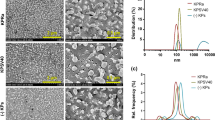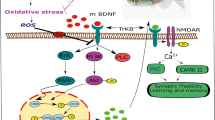Abstract
Purpose
H102, a novel β-sheet breaker peptide, was encapsulated into liposomes to reduce its degradation and increase its brain penetration through intranasal administration for the treatment of Alzheimer’s disease (AD).
Methods
The H102 liposomes were prepared using a modified thin film hydration method, and their transport characteristics were tested on Calu-3 cell monolayers. The pharmacokinetics in rats’ blood and brains were also investigated. Behavioral experiments were performed to evaluate the improvements on AD rats’ spatial memory impairment. The neuroprotective effects were tested by detecting acetylcholinesterase (AchE), choline acetyltransferase (ChAT) and insulin degrading enzyme (IDE) activity and conducting histological assays. The safety was evaluated on rats’ nasal mucosa and cilia.
Results
The liposomes prepared could penetrate Calu-3 cell monolayers consistently. After intranasal administration, H102 could be effectively delivered to the brain, and the AUC of H102 liposomes in the hippocampus was 2.92-fold larger than that of solution group. H102 liposomes could excellently ameliorate spatial memory impairment of AD model rats, increase the activities of ChAT and IDE and inhibit plaque deposition, even in a lower dosage compared with H102 intranasal solution. H102 nasal formulations showed no toxicity on nasal mucosa.
Conclusions
The H102-loaded liposome prepared in this study for nasal administration is stable, effective and safe, which has great potential for AD treatment.








Similar content being viewed by others
Abbreviations
- AChE:
-
Acetylcholinesterase
- AD:
-
Alzheimer’s disease
- Aβ:
-
β-amyloid protein
- BBB:
-
Blood–brain barrier
- CD:
-
Circular dichroism
- ChAT:
-
Choline acetyltransferase
- CNS:
-
Central nervous system
- CL:
-
Cerebellum
- CR:
-
Cerebrum
- EPC:
-
Egg phosphatidylcholine
- HI:
-
Hippocampus
- IDE:
-
Insulin degrading enzyme
- OB:
-
Olfactory bulb
- PEG:
-
Poly ethylene glycol
- TEER:
-
Transendothelial electrical resistance
References
Bolukbasi HF, Hatip-Al-Khatib I. Effects of beta-sheet breaker peptides on altered responses of thoracic aorta in rats’ Alzheimer’s disease model induced by intraamygdaloid Aβ40. Life Sci. 2013;92(3):228–36.
Brookmeyer R, Johnson E, Ziegler-Graham K, Arrighi HM. Forecasting the global burden of Alzheimer’s disease. Alzheimers Dement. 2007;3(3):186–91.
Kurz A, Perneczky R. Novel insights for the treatment of Alzheimer’s disease. Prog Neuro-Psychopharmacol Biol Psychiatry. 2011;35(2):373–9.
Liu Y, Hua Q, Lei H, Li P. Effect of Tong Luo Jiu Nao on Aβ-degrading enzymes in AD rat brains. J Ethnopharmacol. 2011;137(2):1035–46.
Chacon MA, Barria MI, Soto C, Inestrosa NC. β-sheet breaker peptide prevents Aβ-induced spatial memory impairments with partial reduction of amyloid deposits. Mol Psychiatry. 2004;9(10):953–61.
Walsh DM, Klyubin I, Fadeeva JV, et al. Naturally secreted oligomers of amyloid β protein potently inhibit hippocampal long-term potentiation in vivo. Nature. 2002;416(6880):535–9.
Bruinsma IB, Karawajczyk A, Schaftenaar G, de Waal RM, Verbeek MM, van Delft FL. A rational design to create hybrid β-sheet breaker peptides to inhibit aggregation and toxicity of amyloid-β. Med Chem Commun. 2011;2(1):60–4.
Lin LX, Bo XY, Tan YZ, Sun FX, Song M, Zhao J, et al. Feasibility of β-sheet breaker peptide-H102 treatment for Alzheimer’s disease based on β-amyloid hypothesis. PLoS One. 2014;9(11), e112052.
Soto C, Kindy MS, Baumann M, Frangione B. Inhibition of Alzheimer’s amyloidosis by peptides that prevent β-sheet conformation. Biochem Biophys Res Commun. 1996;226(3):672–80.
Benedict C, Hallschmid M, Schultes B, Born J, Kern W. Intranasal insulin to improve memory function in humans. Neuroendocrinology. 2007;86(2):136–42.
Vaka SR, Sammeta SM, Day LB, Murthy SN. Delivery of nerve growth factor to brain via intranasal administration and enhancement of brain uptake. J Pharm Sci. 2009;98(10):3640–6.
Ma YP, Ma MM, Cheng SM, et al. Intranasal bFGF-induced progenitor cell proliferation and neuroprotection after transient focal cerebral ischemia. Neurosci Lett. 2008;437(2):93–7.
Feng C, Zhang C, Shao X, et al. Enhancement of nose-to-brain delivery of basic fibroblast growth factor for improving rat memory impairments induced by co-injection of beta-amyloid and ibotenic acid into the bilateral hippocampus. Int J Pharm. 2012;423(2):226–34.
Illum L. Transport of drugs from the nasal cavity to the central nervous system. Eur J Pharm Sci. 2000;11(1):1–18.
Zhang C, Zheng X, Wan X, et al. The potential use of H102 peptide-loaded dual-functional nanoparticles in the treatment of Alzheimer’s disease. J Control Release. 2014;192:317–24.
Cao S, Ren X, Zhang Q, et al. In situ gel based on gellan gum as new carrier for nasal administration of mometasone furoate. Int J Pharm. 2009;365(1):109–15.
Yuan J. Estimation of variance for AUC in animal studies. J Pharm Sci. 1993;82(7):761–3.
Takeda S, Sato N, Niisato K, et al. Validation of Aβ1-40 administration into mouse cerebroventricles as an animal model for Alzheimer disease. Brain Res. 2009;1280:137–47.
Jiang XG, Cui JB, Fang XL, Wei Y, Xi NZ. Toxicity of drugs on nasal mucocilia and the method of its evaluation. Yao Xue Xue Bao. 1995;30(11):848–53.
Kumaraswamy P, Sethuramanand S, Krishnan UM. Development of a dual nanocarrier system as a potential stratagem against amyloid-induced toxicity. Expert Opin Drug Deliv. 2014;11(8):1131–47.
Driton V, Ruth E, Angeles H, Luca C, Martin G, Lisbeth I, et al. Tight junction modulation by chitosan nanoparticles: comparison with chitosan solution. Int J Pharm. 2010;400(1–2):183–93.
Zheng C, Guo Q, Wu Z, Sun L, Zhang Z, Li C, et al. Amphiphilic glycopolymer nanoparticles as vehicles for nasal delivery of peptides and proteins. Eur J Pharm Sci. 2013;49(4):474–82.
Vllasaliu D, Casettari L, Fowler R, Exposito-Harris R, Garnett M, Illum L, et al. Absorption-promoting effects of chitosan in airway and intestinal cell lines: a comparative study. Int J Pharm. 2012;430(1):151–60.
Illum L. Nanoparticulate systems for nasal delivery of drugs: a real improvement over simple systems? J Pharm Sci. 2007;96(3):473–83.
Kean T, Thanou M. Biodegradation, biodistribution and toxicity of chitosan. Adv Drug Deliv Rev. 2010;62(1):3–11.
Abhay U, Renee R, Wyatt N, Don L, Peter W. Microfluidic preparation of liposomes to determine particle size influence on cellular uptake mechanisms. Pharm Res. 2014;31(2):401–13.
Lotjonen J, Wolz R, Koikkalainen J, Julkunen V, Thurfjell L, Lundqvist R, et al. Fast and robust extraction of hippocampus from MR images for diagnostics of Alzheimer’s disease. NeuroImage. 2011;56(1):185–96.
Liu Q, Shen Y, Chen J, Gao X, Feng C, Wang L, et al. Nose-to-brain transport pathways of wheat germ agglutinin conjugated PEG-PLA nanoparticles. Pharm Res. 2012;29(2):546–58.
Dhuria SV, Hanson LR, Frey 2nd WH. Intranasal delivery to the central nervous system: mechanisms and experimental considerations. J Pharm Sci. 2010;99(4):1654–73.
Liu QF, Shen YH, Chen J, Gao XL, Feng CC, Wang L, et al. Nose-to-brain transport pathways of wheat germ agglutinin conjugated PEG-PLA nanoparticles. Pharm Res. 2012;29(2):546–58.
Carvajal FJ, Inestrosa NC. Interactions of AChE with Aβ aggregates in Alzheimer’s brain: therapeutic relevance of IDN 5706. Front Mol Neurosci. 2011;4:19.
Miners JS, Baig S, Palmer J, Palmer LE, Kehoe PG, Love S. Aβ-degrading enzymes in Alzheimer’s disease. Brain Pathol. 2008;18(2):240–52.
Funalot B, Ouimet T, Claperon A, et al. Endothelin-converting enzyme-1 is expressed in human cerebral cortex and protects against Alzheimer’s disease. Mol Psychiatry. 2004;9(12):1122–8. 1058.
McGowan E, Eriksen J, Hutton M. A decade of modeling Alzheimer’s disease in transgenic mice. Trends Genet. 2006;22(5):281–9.
Chen F, David D, Ferrari A, Gotz J. Posttranslational modifications of tau-role in human tauopathies and modeling in transgenic animals. Curr Drug Targets. 2004;5(6):503–15.
Johann M, Vanessa V, Laurent G, Tangui M. The γ-secretase inhibitor 2-[(1R)-1-[(4-chlorophenyl)sulfonyl](2,5-difluorophenyl) amino]ethyl-5-fluorobenzenebutanoic acid (BMS-299897) alleviates Aβ1–42 seeding and short-term memory deficits in the Aβ25–35 mouse model of Alzheimer’s disease. Eur J Pharmacol. 2013;698(1–3):193–9.
Capurro V, Busquet P, Lopes J, Bertorelli R, Tarozzo G, Bolognesi M, et al. Pharmacological characterization of memoquin, a multi-target compound for the treatment of Alzheimer’s disease. PLoS ONE. 2013;8(2), e56870.
Van DD, De Deyn PP. Drug discovery in dementia: the role of rodent models. Nat Rev Drug Discov. 2006;5(11):956–70.
Nomura I, Takechi H, Kato N. Intraneuronally injected amyloid beta inhibits long-term potentiation in rat hippocampal slices. J Neurophysiol. 2012;107(9):2526–31.
Lian T, Ho RJ. Trends and developments in liposome drug delivery systems. J Pharm Sci. 2001;90(6):667–80.
Samad A, Sultana Y, Aqil M. Liposomal drug delivery systems: an update review. Curr Drug Deliv. 2007;4(4):297–305.
Pujol I, Serracant A, Cano M, Ampudia RM, Rodriguez S, Sanchez A. Use of autoantigen-loaded phosphatidylserine-liposomes to arrest autoimmunity in type 1 diabetes. PLoS ONE. 2015;10(6), e0127057.
ACKNOWLEDGMENTS AND DISCLOSURES
This work was supported by grants from the National Science and Technology Major Project 2009ZX09103-029 and The Open Project Program of Key Lab of Smart Drug Delivery (Fudan University), Ministry of Education, China.
Author information
Authors and Affiliations
Corresponding author
Additional information
Xiaoyao Zheng and Xiayan Shao contributed equally to this work.
Rights and permissions
About this article
Cite this article
Zheng, X., Shao, X., Zhang, C. et al. Intranasal H102 Peptide-Loaded Liposomes for Brain Delivery to Treat Alzheimer’s Disease. Pharm Res 32, 3837–3849 (2015). https://doi.org/10.1007/s11095-015-1744-9
Received:
Accepted:
Published:
Issue Date:
DOI: https://doi.org/10.1007/s11095-015-1744-9




